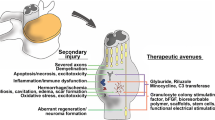Abstract
Acute traumatic spinal cord injury primarily afflicts young people and significantly reduces independence, bestows life-long disability, and consumes huge societal resources. The estimated incidence of acute traumatic spinal cord injury in North America varies from 27–81 cases per million inhabitants per year [1]. The prevalences of spinal cord injury were estimated to be 280 and 681 individuals per million inhabitants in Finland and Australia, respectively. Despite recent efforts at prevention, including laws mandating seat belt use, the incidence of spinal cord injury has not changed significantly and may actually be increasing in certain parts of the population [2, 3]. In addition, the estimated (2006) treatment cost of spinal cord injury is $9.7 billion per year [1]. A number of pharmacological agents (methylprednisolone sodium succinate, and the related compound, tirilazad mesylate; GM-I ganglioside; thyrotropin-releasing hormone; gacyclidine; naloxone; and nimodipine) have been investigated in large, prospective, randomized, controlled clinical trials, but all have failed to demonstrate convincing neurological benefit. Spinal cord injury is frequently associated with systemic hypotension attributable to hypovolemia, direct spinal cord trauma, or both [4].
Access this chapter
Tax calculation will be finalised at checkout
Purchases are for personal use only
Preview
Unable to display preview. Download preview PDF.
Similar content being viewed by others
References
Wyndaele M, Wyndaele JJ (2006) Incidence, prevalence and epidemiology of spinal cord injury: what learns a worldwide literature survey? Spinal Cord 44: 523–529
Krause JS (2000) Aging after spinal cord injury: An exploratory study. Spinal Cord 38: 77–83
Marshall LF (2000) Epidemiology and cost of central nervous system injury. Clin Neurosurg 46: 105–112
Congress of Neurological Surgeons (2002) Blood pressure management after acute spinal cord injury. Neurosurgery 50: S58–62
Furlan JC, Fehlings MG (2008) Cardiovascular complications after acute spinal cord injury: pathophysiology, diagnosis, and management. Neurosurg Focus 25: E13
Furlan JC, Fehlings MG, Shannon P, Norenberg MD, Krassioukov AV (2003) Descending vasomotor pathways in humans: correlation between axonal preservation and cardiovascular dysfunction after spinal cord injury. J Neurotrauma 20: 1351–1363
Bilello JF, Davis JW, Cunningham MA, Groom TF, Lemaster D, Sue LP (2003) Cervical spinal cord injury and the need for cardiovascular intervention. Arch Surg 138: 1127–1129
Guly HR, Bouamra O, Lecky FE (2008) The incidence of neurogenic shock in patients with isolated spinal cord injury in the emergency department. Resuscitation 76: 57–62
Tuli S, Tuli J, Coleman WP, Geisler FH, Krassioukov A (2007) Hemodynamic parameters and timing of surgical decompression in acute cervical spinal cord injury. J Spinal Cord Med 30: 482–490
Lehmann KG, Lane JG, Piepmeier JM, Batsford WP (1987) Cardiovascular abnormalities accompanying acute spinal cord injury in humans: incidence, time course and severity. J Am Coll Cardiol 10: 46–52
Piepmeier JM, Lehmann KB, Lane JG (1985) Cardiovascular instability following acute cervical spinal cord trauma. Cent Nerv Syst Trauma 2: 153–160
Consortium for Spinal Cord Medicine (2008) Early acute management in adults with spinal cord injury: A clinical practice guideline for health-care professionals. J Spinal Cord Med 31: 403–479
Vale FL, Burns J, Jackson AB, Hadley MN (1997) Combined medical and surgical treatment after acute spinal cord injury: results of a prospective pilot study to assess the merits of aggressive medical resuscitation and blood pressure management. J Neurosurg 87: 239–246
Levi L, Wolf A, Belzberg H (1993) Hemodynamic parameters in patients with acute cervical cord trauma: description, intervention, and prediction of outcome. Neurosurgery 33: 1007–1016
Wolf A, Levi L, Mirvis S, Ragheb J, Huhn S, Rigamonti D, Robinson WL (1991) Operative management of bilateral facet dislocation. J Neurosurg 75: 883–890
Tator CH, Rowed DW, Schwartz ML, et al (1984) Management of acute spinal cord injuries. Can J Surg 27: 289–293
Zach GA, Seiler W, Dollfus P (1976) Treatment results of spinal cord injuries in the Swiss Paraplegic Centre of Basle. Paraplegia 14: 58–65
Bratton SL, Chestnut RM, Ghajar J, et al (2007) Guidelines for the management of severe traumatic brain injury. IX. Cerebral perfusion thresholds. J Neurotrauma 24(Suppl 1): S59–64
Rangel-Castilla L, Gasco J, Nauta HJ, Okonkwo DO, Robertson CS (2008) Cerebral pressure autoregulation in traumatic brain injury. Neurosurg Focus 25: E7
Miyamoto K, Ueno A, Wada T, Kimoto S (1960) A new and simple method of preventing spinal cord damage following temporary occlusion of the thoracic aorta by draining the cerebrospinal fluid. J Cardiovasc Surg (Torino) 1: 188–197
Coselli JS, Lemaire SA, Koksoy C, Schmittling ZC, Curling PE (2002) Cerebrospinal fluid drainage reduces paraplegia after thoracoabdominal aortic aneurysm repair: results of a randomized clinical trial. J Vase Surg 35: 631–639
Cina CS, Abouzahr L, Arena GO, Lagana A, Devereaux PJ, Farrokhyar F (2004) Cerebrospinal fluid drainage to prevent paraplegia during thoracic and thoracoabdominal aortic aneurysm surgery: A systematic review and meta-analysis. J Vase Surg 40: 36–44
Kwon BK, Curt A, Belanger LM et al (2009) Intrathecal pressure monitoring and cerebrospinal fluid drainage in acute spinal card injury: A prospective randomized trial. J Neurosurg Spine 10: 181–193
Contant CF, Valadka AB, Gopinath SP, Hannay HJ, Robertson CS (2001) Adult respiratory distress syndrome: A complication of induced hypertension after severe head injury. J Neurosurg 95: 560–568
Wynn MM, Mell MW, Tefera G, Hoch JR, Acher CW (2009) Complications of spinal fluid drainage in thoracoabdominal aortic aneurysm repair: A report of 486 patients treated from 1987 to 2008. J Vasc Surg 49: 29–34
Guha A, Tator CH, Rochon J (1989) Spinal cord blood flow and systemic blood pressure after experimental spinal cord injury in rats. Stroke 20: 372–377
Levi L, Wolf A, Rigamonti D, Ragheb J, Mirvis S, Robinson WL (1991) Anterior decompression in cervical spine trauma: does the timing of surgery affect the outcome? Neurosurgery 29: 216–222
Author information
Authors and Affiliations
Editor information
Editors and Affiliations
Rights and permissions
Copyright information
© 2010 Springer Science + Business Media Inc.
About this paper
Cite this paper
Solaiman, O., Zygun, D. (2010). Hemodynamic Management of Acute Spinal Cord Injury. In: Vincent, JL. (eds) Intensive Care Medicine. Springer, New York, NY. https://doi.org/10.1007/978-1-4419-5562-3_37
Download citation
DOI: https://doi.org/10.1007/978-1-4419-5562-3_37
Publisher Name: Springer, New York, NY
Print ISBN: 978-1-4419-5561-6
Online ISBN: 978-1-4419-5562-3
eBook Packages: MedicineMedicine (R0)




